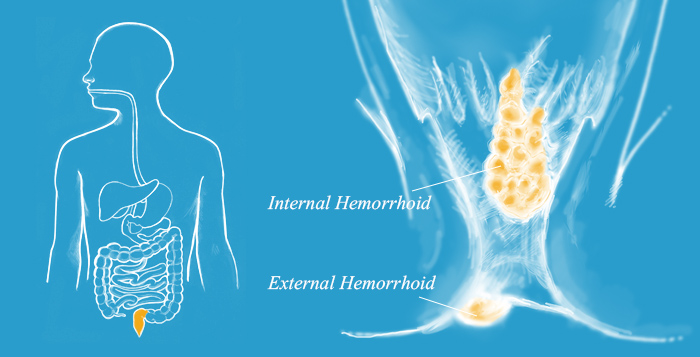
Hemorrhoids are areas of tissue around the anus with congested (swollen) blood vessels. They are caused by chronic constipation, a low fiber diet, and are common in pregnancy as well. Symptoms include pain, bleeding, protrusion, and seepage. Chronic hemorrhoids can be associated with itching. External hemorrhoids are located near the anus and can present with a blood clot. Internal hemorrhoids are in the anal wall and may not be noticed until they bleed or protrude. Initial treatment of hemorrhoids includes treatment of constipation, creams, sitz baths, and encouraging exercise to improve colon regularity. Surgery may be recommended if these measures fail or if a patient has an emergent situation.
Surgery
Patients may present with a thrombosed external hemorrhoid (one with a blood clot inside). This situation is best treated by incising (opening) the hemorrhoid and extracting the blood clot followed by sitz baths and soothing creams. Protruding internal hemorrhoids that will not reduce (go back into the anus) may require immediate open hemorrhoidectomy. This type of surgery involves excising (removing) the hemorrhoid or hemorrhoids. This procedure can be quite painful postoperatively but is effective in dealing with this emergent situation.
Other surgical options include hemorrhoid banding. This procedure involves putting bands at the base of internal hemorrhoids. It causes relatively little pain but may require multiple procedures to eliminate several hemorrhoids. A new procedure for significant internal or external hemorrhoids is called a stapled hemorrhoidectomy or hemorrhoidopexy. This procedure is accomplished with a special stapling device that removes and divides the area where the blood vessels become inflamed. In doing so, the areas of hemorrhoid have a decreased blood supply and are often pulled up inside the rectum.
Newer technologies for minimally invasive treatment of hemorrhoids are emerging and these options may be offered to you as well.
Pre-Operative Instructions:
- Bowel preparation is required for this operation. Recommendations for enemas to cleanse the area will be given and this should be performed the day before surgery.
- A patient should not eat or drink anything after midnight the night before surgery.
- Lab work may be required prior to surgery. This will be scheduled for you.
- Clearance by your primary care physician or a cardiologist may be required prior to surgery. Please bring any notes with you to the office or on the day of surgery.
- Please discontinue aspirin and any other blood thinners at least 5 days prior to your surgery. Call your primary care physician before discontinuing any prescription drugs.
- Our primary care physician or anesthesia should address other questions regarding your usual prescription medications.
Post-Operative Instructions:
- Surgeries are usually performed in an outpatient setting where a patient returns home the same day after surgery.
- Resume a regular diet as tolerated.
- Resume other activities as tolerated.
- Plan to be off from work for several days. Some people may be able to return to work sooner.
- Driving is not permitted while taking narcotic pain medication (Vicodin) and while a patient is not able to apply the brake safely in an emergency. Driving is not recommended for a couple of days.
- Constipation can be a common problem following this operation. Milk of magnesia can be helpful with this problem. Please contact the office if you are having continued difficulty with constipation.
- Some patients have difficulty with urination following surgery. Please contact the office or go to the emergency room if you unable to void for more than 8 hours after surgery. Serious bladder damage can result if this problem is not addressed.
- Sitz baths are recommended after hemorrhoid surgery. This involves sitting in warm water for 15 minutes at least 3 times a day.
- Expect some bleeding and drainage following these surgeries. Excessive bleeding should be reported.
- Fever and severe pain are other reasons to contact the office.
- Schedule a follow-up appointment 2 weeks after surgery.